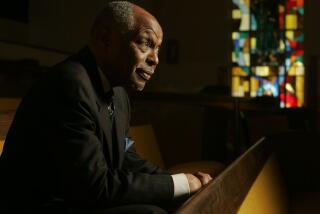From the Archives: Op-Ed: America’s long history of black churches burning
As African Americans in Texas and North Carolina contemplate rebuilding three more churches destroyed by fire, a phalanx of federal investigators moves across the South, searching for evidence linking the latest attacks to the burning of 29 other black churches in the last 18 months. So far, investigators have yet to uncover evidence of a “national conspiracy.” The bulk of the attacks appear to be “random” acts of vandalism, the work of “teenagers” and “copycats” rather than hardened conspirators.
It is worth observing that the absence of any organized conspiracy may make the phenomenon of church burning more, rather than less, disturbing. Far easier to abide the idea of a tight-knit group of racist fanatics than to accept the alternative that we live in a time when a substantial number of individuals, unconnected with one another or with organized white supremacist groups, regard burning black churches as a plausible act, worthy of emulation.
Such a prospect becomes even more sobering when one places church burning in historical context. Most commentators and political leaders, including President Bill Clinton, have noted parallels between recent events and attacks on black churches during the civil rights era. Torching black churches, however, has a far longer pedigree in the United States. Indeed, for as long as there have been separate black churches, there have been whites determined to destroy them.
The roots of independent black Christianity reach back to the late 18th century, when African Americans in Philadelphia, Baltimore and a handful of other cities, facing a rising tide of racial hostility, withdrew from white denominations and established their own churches. Philadelphia’s Mother Bethel African Methodist Episcopal Church, the country’s oldest black congregation and the progenitor of the South Carolina church Clinton helped rededicate last week, was founded in 1792, after white Methodists attempted to remove their black coreligionists to the back of a newly constructed gallery. In an era that afforded African Americans few opportunities for autonomy and self-assertion, Mother Bethel and churches like it became vehicles for community organizing -- for sustaining black schools, businesses and benevolent societies, and for combating slavery and the menace of “colonization,” the proposed deportation of free people of color back to Africa.
Precisely because they expressed black aspirations for autonomy, respectability and, ultimately, equality, black churches antagonized many whites. “Their aspirings and little vanities have been growing since they got those separate churches,” wrote a Philadelphia historian in 1830. “Once they submitted to the appellation of servants, blacks or Negroes, but now they require to be called coloured people, and among themselves, their common salutation is -- gentlemen and ladies.”
From such sentiments it was but a short step to violence. In 1829, white mobs rampaged through Cincinnati’s African American ward, torching churches, schools, businesses and other signs of black autonomy and prosperity. Black Philadelphians endured six similar attacks in the 25 years between 1825 and 1850. In an 1834 riot, two black churches, one Methodist, one Presbyterian, were razed. Mother Bethel A.M.E. Church did not escape unscathed. In 1825, a gang of young ruffians poured red pepper into the stove during a service. A stampede ensued, as worshipers struggled to escape the choking smoke. Four people died.
While the circumstances of these riots were historically specific, there are patterns suggestive for our time. The 1830s and 1840s, like the 1980s and 1990s, were decades of momentous economic transformation, as Americans adapted to the opportunities and perils of an emerging national marketplace. Native-born whites, extruded from the countryside, competed for jobs and urban space with African Americans and a swelling tide of European immigrants. For many, the American dream of independence and upward mobility had gone aglimmering.
This climate of insecurity represented both a challenge and an opportunity to white political leaders. Leaders of the Democratic Party were particularly adept at playing what we today call “the race card,” using the idea of shared “whiteness” to cement an unlikely coalition of native-born workers, European (especially Irish) immigrants and pro-slavery Southerners. All across the North, African Americans faced disenfranchisement and a battery of discriminatory “black codes,” some of which went so far as to deny rights of settlement to all black people, slave or free.
It takes little imagination to see why, in such a context, some whites would take it upon themselves to burn black churches, the most visible signs of African Americans’ presence and self-possession.
Church burning remained a largely northern phenomenon in the antebellum years, primarily because white Southerners rarely allowed blacks to build their own churches. In this as in so many other ways, emancipation represented a revolution. All across the South, freed people founded independent schools, fraternal orders, benevolent societies, fire companies and, above all, churches. For former slaves, the right to congregate openly and without white scrutiny was a central dimension of freedom.
Jim Campbell, an assistant professor of history at Northwestern University, is the author of “Songs of Zion: The African Methodist Episcopal Church in the United States and South Africa” (Oxford University Press), which won the Frederick Jackson Turner prize.
More to Read
Sign up for Essential California
The most important California stories and recommendations in your inbox every morning.
You may occasionally receive promotional content from the Los Angeles Times.










